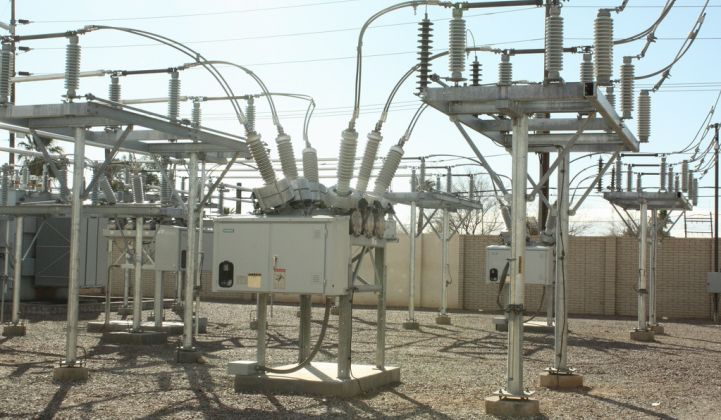UtiliData may be a small player amongst giants in the field of digitally controlling grid voltage. But if its AdaptiVolt system works as well as planned -- and as certain pilot projects seem to predict -- it could become a real contender against the giants competing for the multi-billion dollar market.
To test that concept, UtiliData announced this week that it had raised an undisclosed investment from Braemar Energy Ventures. Jeremy Wilson, UtiliData’s director of technical sales, wouldn’t say how much money the company raised in a Monday interview. But he did say the money would be spent to build its AdaptiVolt system into “a product that’s scalable to large utility customers,” and that it was aiming at cutting the per-feeder line costs of today’s systems in half.
This is the first venture investment for the decade-old utility automation company, but not the first test of its conservation voltage reduction (CVR) technology. That’s been running since 2003 in pilots around the country, for utility customers as well as big power users like lumber mills and universities.
One of UtiliData’s biggest pilots, with utility AEP in Ohio, has showed results indicating that UtiliData’s Digital Signal Processing (DSP) methods may outperform rival script- and model-based systems, Wilson said. That’s a key part of UtiliData’s differentiation from its rivals/partners in the market, so it’s worth going into in more detail.
UtiliData is just one of many smart grid contenders in the volt/VAR optimization (VVO) field, which consists of software and grid equipment that controls voltage more finely. The grid has to stay within a certain voltage range to avoid brownouts or overloading circuits, but because voltage weakens as current reaches the edges of the network, utilities have typically run them for safety, not for conservation.
Yet every unnecessary volt means power that’s being wasted -- and power that can be reduced, either to drive efficiency or to manage moments when the grid is under peak demand stress. Such conservation voltage reduction (CVR) projects around the country are starting to show results of two percent to three percent energy savings overall, usually based on a centralized distribution management system (DMS) that controls the equipment in the field.
According to Wilson, most of today’s volt/VAR optimization systems are either rule-based or model-based. Rule, or script-based systems, use equipment that’s pre-programmed to react to certain grid changes, he said. But getting them to change to real-world grid conditions requires uploading simple script changes, something many aren’t built to do.
Then there’s model-based, which creates an accurate power flow model of the grid itself in digital form. These models accurately measure real power flow -- but only as long as the model doesn’t change, Wilson said. Bring down power lines in a storm, and the model has to be adjusted to reflect that change in real time, or it will deliver inaccurate results, he said.
AdaptiVolt, on the other hand, reads the digital voltage signals to make its decisions, which should make it more flexible than script- or model-based systems, he said.
“Every signal that’s recorded in the field contains information about the behavior of the distribution system,” he told me in a Wednesday interview. “We extract information to get transmission system, distribution system and customer behavior, […] look at real-time behavior of the system, and make control decisions.”
UtiliData’s DSP methods allow it to capture more voltage savings, roughly 1 percent to 1.5 percent more than rule- or model-based systems, Wilson contends, which would add up to 30 percent to 40 percent better performance. It also helps fix a problem other systems have with automated load tap changers, which tend to activate more often when CVR equipment is in play, he said. UtiliData’s system, on the other hand, takes control to reduce tap changer use, which should add up to a longer life for those expensive pieces of equipment, he said.
If there’s a catch, it’s in the heavy IT load that DSP brings to the grid. Crunching real-time power data from the field requires some pretty robust communications, which not all projects have. UtiliData has built data loss protection into the system, but might not be able to realize the full value of digital signal processing without getting enough data.
UtiliData isn’t the only smart grid vendor using digital signal processing. Competitors like ABB and Schweitzer use it for its substation protective relays and other larger-scale automation projects. Jeffrey Taft, former IBM engineer who’s now Cisco’s smart grid architect, has written that DSP is the key to a truly smart grid -- a fact that’s surely built into Cisco’s smart grid plans.
But Wilson said that using DSP at the feeder-line scale that UtiliData is targeting is more rare. Today’s CVR and VVO systems cost about $200,000 to $250,000 per feeder, he estimated. UtiliData wants to cut that per-feeder cost by as much as half, he said. While many systems, including UtiliData's, can run as a centralized platform or at the substation level, Wilson said targeting the smaller portion of "problem feeders" that are costing utilities the most money in energy waste and maintenance issues could lead to faster deployments.
UtiliData is working with Silver Spring Networks on its AEP pilot, and interoperates with the smart grid networking startup’s wireless mesh system, Wilson said. But it also communicates via standard SCADA protocols to distribution sensor and control gear -- transformers, capacitor banks, load tap changers and the like -- from practically every big vendor in the space, he said.
The company has funded itself through ongoing operations up to this point, Wilson said, without commenting on the company’s revenues. The Spokane, Wash.-based company plans to move headquarters to Providence, R.I. in March, following a $500,000 grant from the state, and expects to roughly double its workforce of 50 employees over the next few years.



